window CHEVROLET EXPRESS 1997 1.G Owners Manual
[x] Cancel search | Manufacturer: CHEVROLET, Model Year: 1997, Model line: EXPRESS, Model: CHEVROLET EXPRESS 1997 1.GPages: 386, PDF Size: 20.32 MB
Page 15 of 386
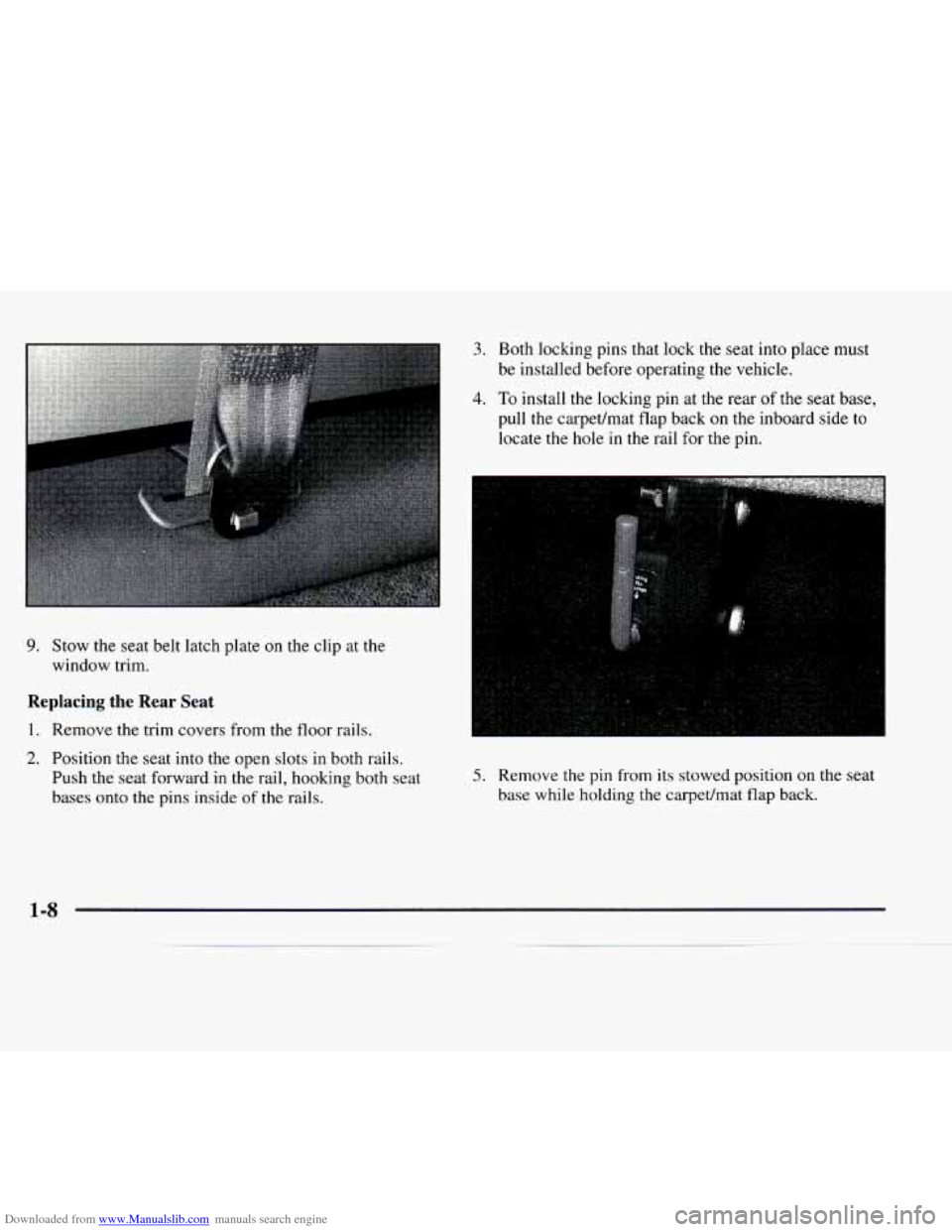
Downloaded from www.Manualslib.com manuals search engine 9. Stow the seat belt latch plate on the clip at the
window trim.
Replacing the Rear Seat
1. Remove the trim covers from the floor rails.
2. Position the seat into the open slots in both rails.
Push the seat forward in the rail, hooking both seat
bases onto the pins inside
of the rails.
3. Both locking pins that lock the seat into place must
be installed before operating the vehicle.
4. To install the locking pin at the rear of the seat base,
pull the carpetlmat flap back on the inboard side
to
locate the hole in the rail for the pin.
5. Remove the pin from its stowed position on the seat
base while holding the carpevmat flap back.
Page 37 of 386
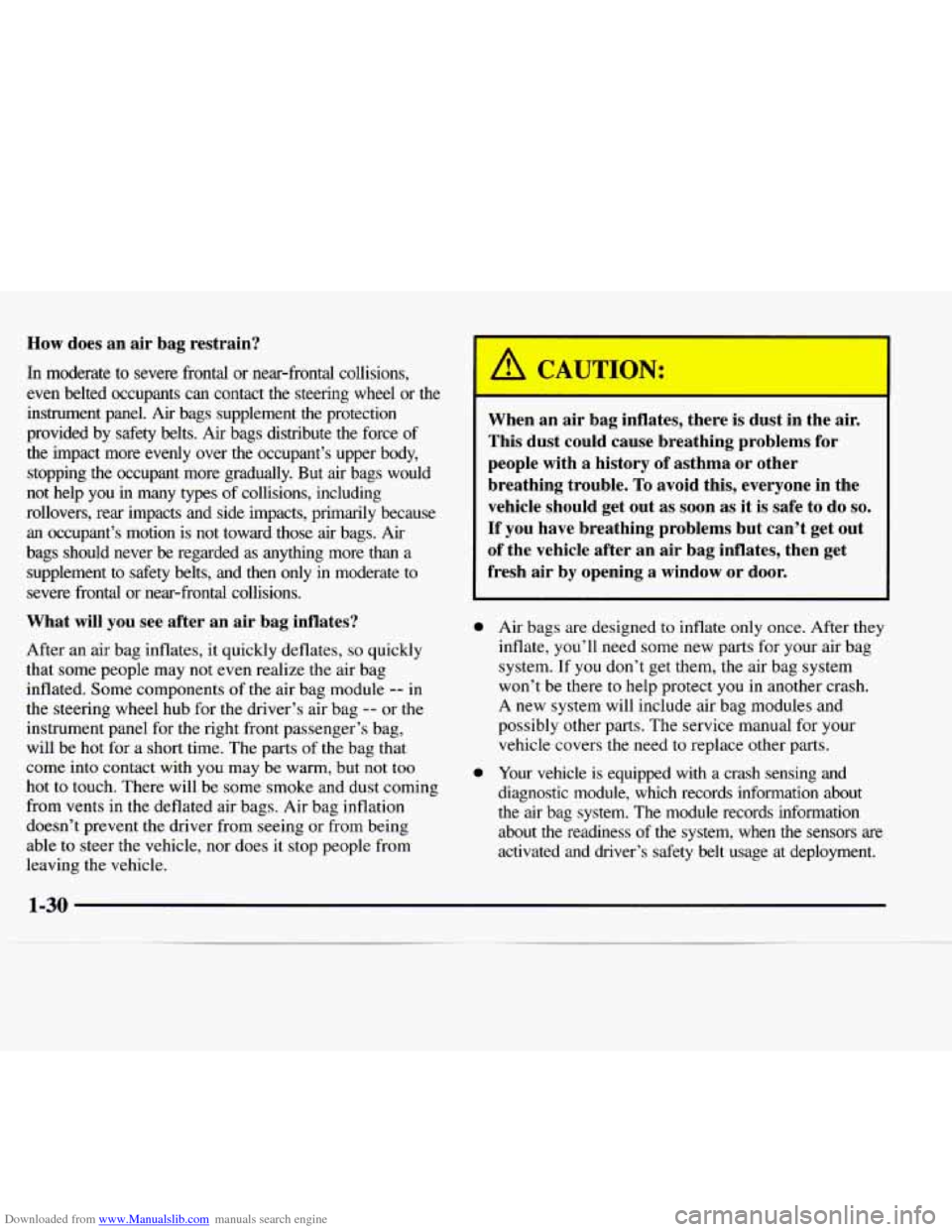
Downloaded from www.Manualslib.com manuals search engine How does an air bag restrain?
In moderate to severe frontal or near-frontal collisions,
even belted occupants can contact the steering wheel or the
instrument panel. Air bags supplement the protection
provided by safety belts.
Air bags distribute the force of
the impact more evenly over
the occupant’s upper body,
stopping the occupant more gradually. But air bags would
not help you in many
types of collisions, including
rollovers, rear impacts and side impacts, primarily because
an occupant’s motion is not toward those
air bags. Air
bags should never be regarded as anythmg more than a
supplement to safety belts, and then only in moderate
to
severe frontal or near-frontal collisions.
What will you see after an air bag inflates?
After an air bag inflates, it quickly deflates, so quickly
that some people may not even realize the air bag
inflated. Some components
of the air bag module -- in
the steering wheel hub for the driver’s air bag -- or the
instrument panel for the right front passenger’s bag,
will be
hot for a short time. The parts of the bag that
come into contact with you may be warm, but not
too
hot to touch. There will be some smoke and dust coming
from vents in the deflated air bags. Air bag inflation
doesn’t prevent the driver from seeing or from being
able
to steer the vehicle, nor does it stop people from
leaving the vehicle.
When an air bag inflates, there is dust in the air.
This dust could cause breathing problems for
people with a history
of asthma or other
breathing trouble.
To avoid this, everyone in the
vehicle should get out as soon as it is safe to do
so.
If you have breathing problems but can’t get out
of the vehicle after an air bag inflates, then get
fresh air by opening a window or door.
0
0
Air bags are designed to inflate only once. After they
inflate, you’ll need some new parts for your air bag
system.
If you don’t get them, the air bag system
won’t be there
to help protect you in another crash.
A new system will include air bag modules and
possibly other parts. The service manual for your
vehicle covers the need to replace other parts.
Your vehicle is equipped with a crash sensing and
diagnostic module, which records information about
the air bag system. The module records information
about
the readiness of the system, when the sensors are
activated and driver’s safety belt usage at deployment.
Page 40 of 386
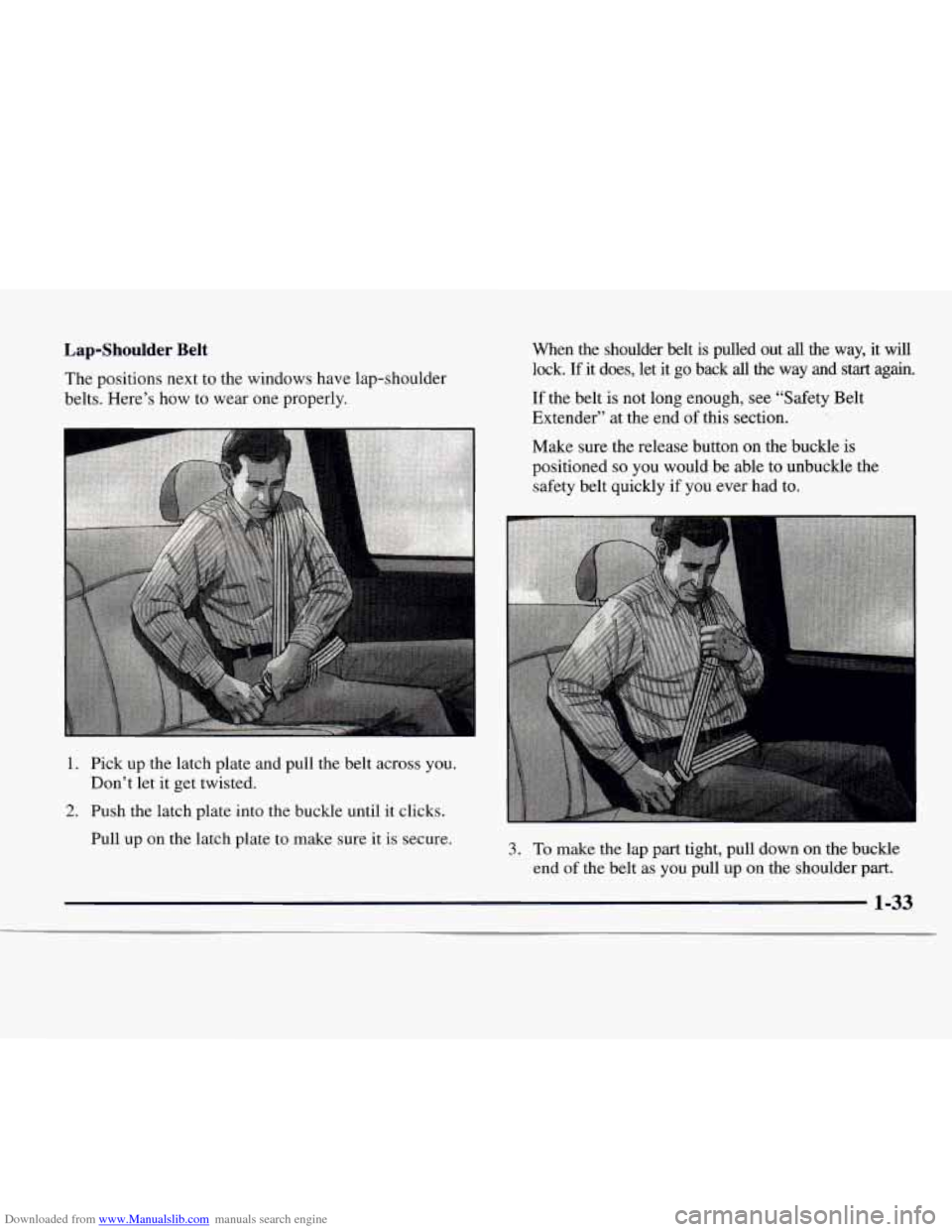
Downloaded from www.Manualslib.com manuals search engine Lap-Shoulder Belt
The positions next to the windows have lap-shoulder
belts. Here’s how to wear one properly.
1. Pick up the latch plate and pull the belt across you.
Don’t let it get twisted.
2. Push the latch plate into the buckle until it clicks.
Pull up on the latch plate to make sure it is secure. When the shoulder belt
is pulled out all the way,
it will
lock. If it does, let it go back all the way and start again.
If the belt is not long enough, see “Safety Belt
Extender” at the end of this section.
Make sure the release button on the buckle is
positioned
so you would be able to unbuckle the
safety belt quickly if you ever had to.
3. To make the lap part tight, pull down on the buckle
end
of the belt as you pull up on the shoulder part.
1-33
Page 56 of 386
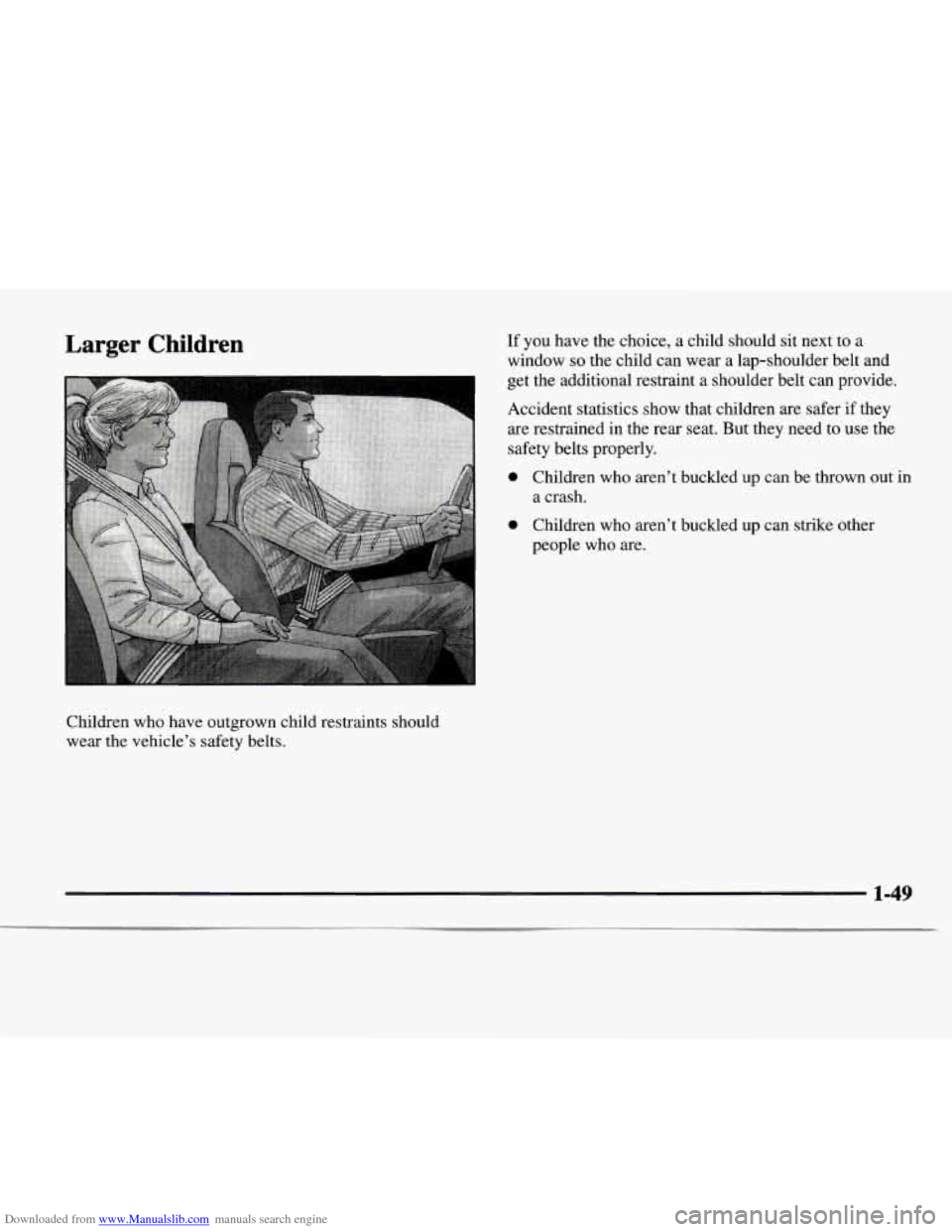
Downloaded from www.Manualslib.com manuals search engine Larger Children
Children who have outgrown child restraints should
wear the vehicle’s safety belts.
If you have the choice, a child should sit next to a
window
so the child can wear a lap-shoulder belt and
get the additional restraint
a shoulder belt can provide.
Accident statistics show that children
are safer if they
are restrained in the rear seat. But they need to use the
safety belts properly.
0 Children who aren’t buckled up can be thrown out in
a crash.
0 Children who aren’t buckled up can strike other
people who are.
1-49
Page 62 of 386
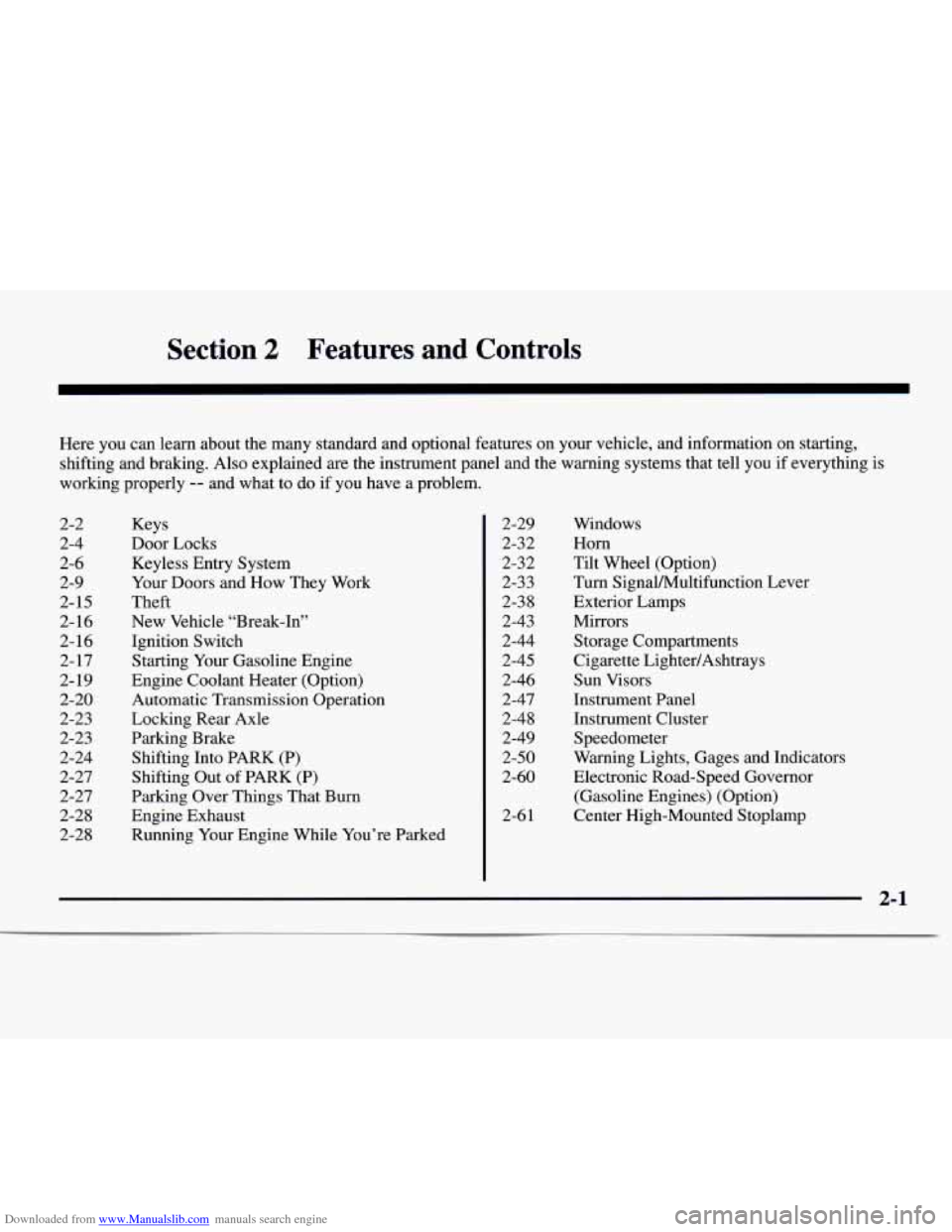
Downloaded from www.Manualslib.com manuals search engine Section 2 Features and Controls
Here you can learn about the many standard and optional features on your vehicle, and information on starting,
shifting and braking. Also explained are the instrument panel and the warning systems that tell you if everything is
working properly
-- and what to do if you have a problem.
2-2
2-4
2-6
2-9
2-15
2-16
2-16
2-17
2-19
2-20
2-23
2-23
2-24
2-27
2-27
2-28
2-28 Keys
Door Locks Keyless Entry System
Your Doors and How They Work
Theft
New Vehicle “Break-In”
Ignition Switch
Starting Your Gasoline Engine
Engine Coolant Heater (Option)
Automatic Transmission Operation
Locking Rear Axle
Parking Brake
Shifting Into PARK
(P)
Shifting Out of PARK (P)
Parking Over Things That Burn
Engine Exhaust
Running Your Engine While You’re Parked
2-29
2-32
2-32
2-33
2-38
2-43
2-44
2-45
2-46
2-47
2-48
2-49
2-50
2-60
2-6
1
Windows
Horn
Tilt Wheel (Option) Turn Signal/Multifunction Lever
Exterior Lamps
Mirrors
Storage Compartments
Cigarette LightedAshtrays
Sun Visors
Instrument Panel
Instrument Cluster
Speedometer
Warning Lights, Gages and Indicators
Electronic Road-Speed Governor
(Gasoline Engines) (Option)
Center High-Mounted Stoplamp
Page 63 of 386
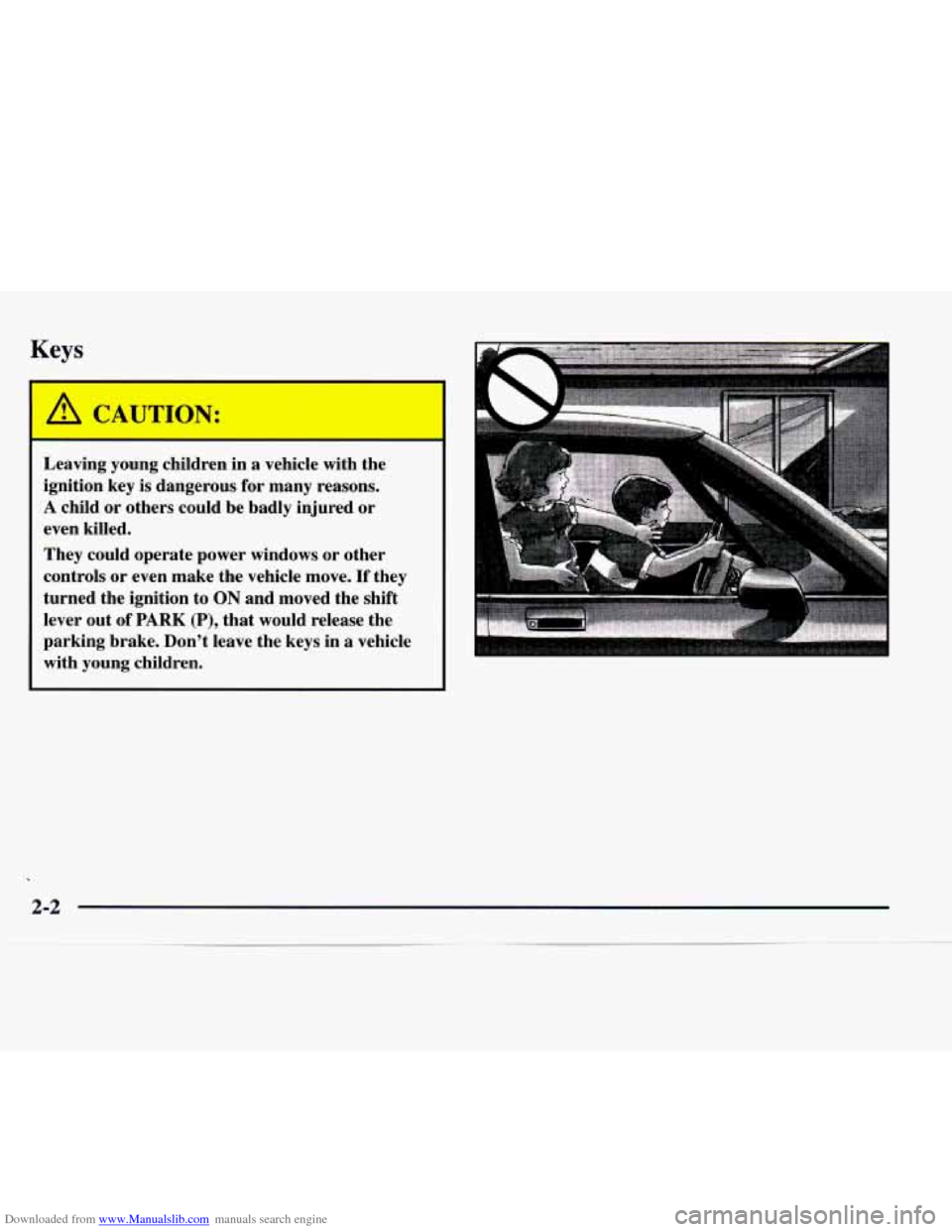
Downloaded from www.Manualslib.com manuals search engine Keys
A CAUTION:
Leaving young children in a vehicle with the
ignition key is dangerous for many reasons.
A child or others could be badly injured or
even killed.
They could operate power windows or other
controls or even make the vehicle move.
If they
turned the ignition to
ON and moved the shift
lever out of
PARK (P), that would release the
parking brake. Don’t leave the keys in a vehicle
with young children.
Page 75 of 386
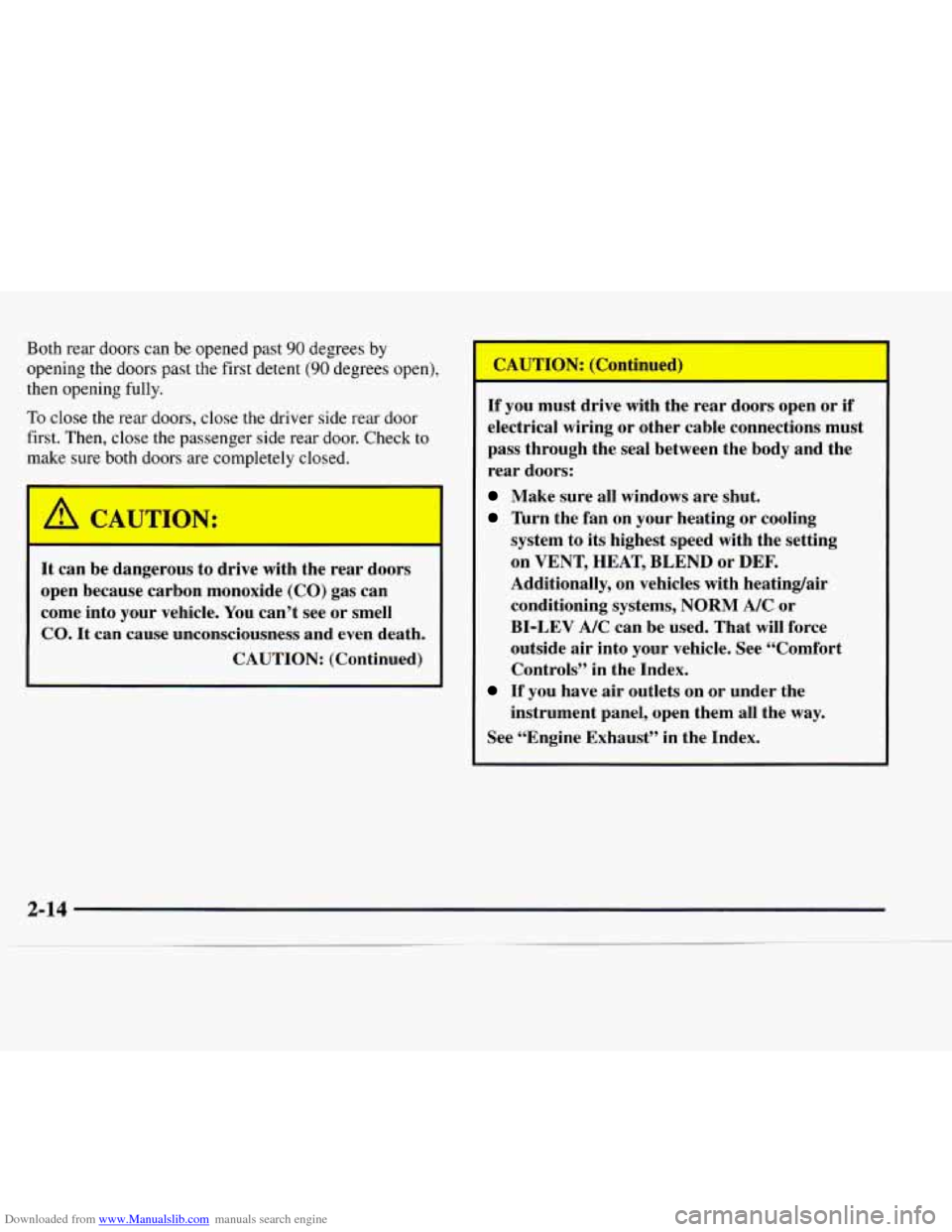
Downloaded from www.Manualslib.com manuals search engine Both rear doors can be opened past 90 degrees by
opening the doors past the first detent
(90 degrees open),
then opening fully.
To close the rear doors, close the driver side rear door
first. Then, close the passenger side rear door. Check
to
make sure both doors are completely closed.
I-
It can be dangerous to drive with the rear doors
open because carbon monoxide (CO) gas can
come into your vehicle. You can’t see or smell
CO.
It can cause unconsciousness and even death.
CAUTION: (Continued) CAUTION:
(Continued)
I
If you must drive with the rear doors open or if
electrical wiring or other cable connections must
pass through the seal between the body and the
rear doors:
Make sure all windows are shut.
lbrn the fan on your heating or cooling
system to its highest speed with the setting
on VENT, HEAT, BLEND or DEF.
Additionally, on vehicles with heatingair
conditioning systems, NORM A/C or
BI-LEV A/C can
be used. That will force
outside air into your vehicle. See “Comfort
Controls” in the Index.
instrument panel, open them all the way.
If you have air outlets on or under the
See “Engine Exhaust” in the Index.
Page 76 of 386
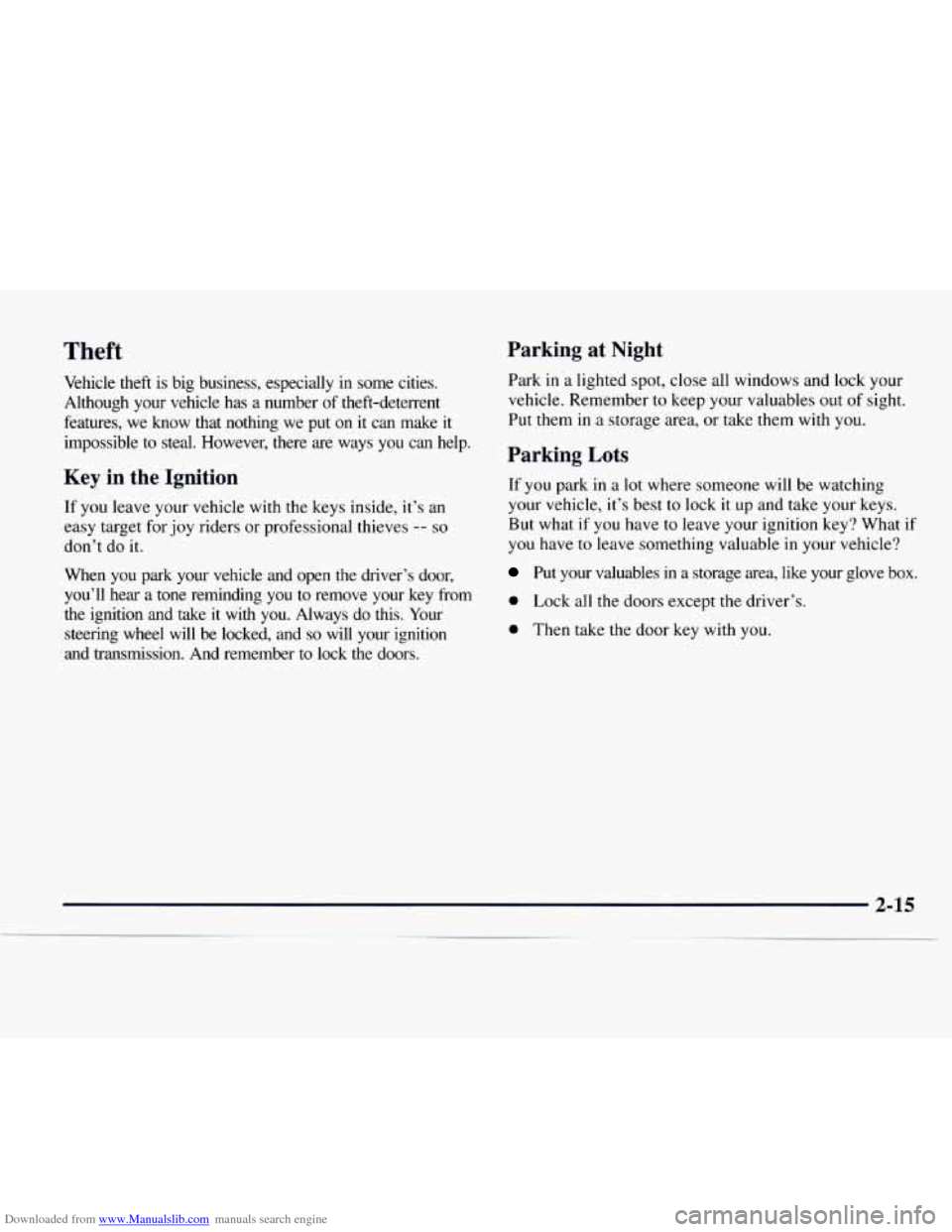
Downloaded from www.Manualslib.com manuals search engine Theft
Vehicle theft is big business, especially in some cities.
Although your vehicle has a number
of theft-deterrent
features, we know that nothing we put
on it can make it
impossible
to steal. However, there are ways you can help.
Key in the Ignition
If you leave your vehicle with the keys inside, it’s an
easy target for joy riders
or professional thieves -- so
don’t do it.
When you park your vehicle and open the driver’s door, you’ll hear a tone reminding you to remove your key from
the ignition and take
it with you. Always do this. Your
steering wheel will be locked, and
so will your ignition
and transmission. And remember to lock the doors.
Parking at Night
Park in a lighted spot, close all windows and lock your
vehicle. Remember to keep your valuables out
of sight.
Put them in
a storage area, or take them with you.
Parking Lots
If you park in a lot where someone will be watching
your vehicle, it’s best
to lock it up and take your keys.
But what if you have
to leave your ignition key? What if
you have to leave something valuable in your vehicle?
Put your valuables in a storage area, like your glove box.
0 Lock all the doors except the driver’s.
0 Then take the door key with you.
2-15
__
Page 77 of 386
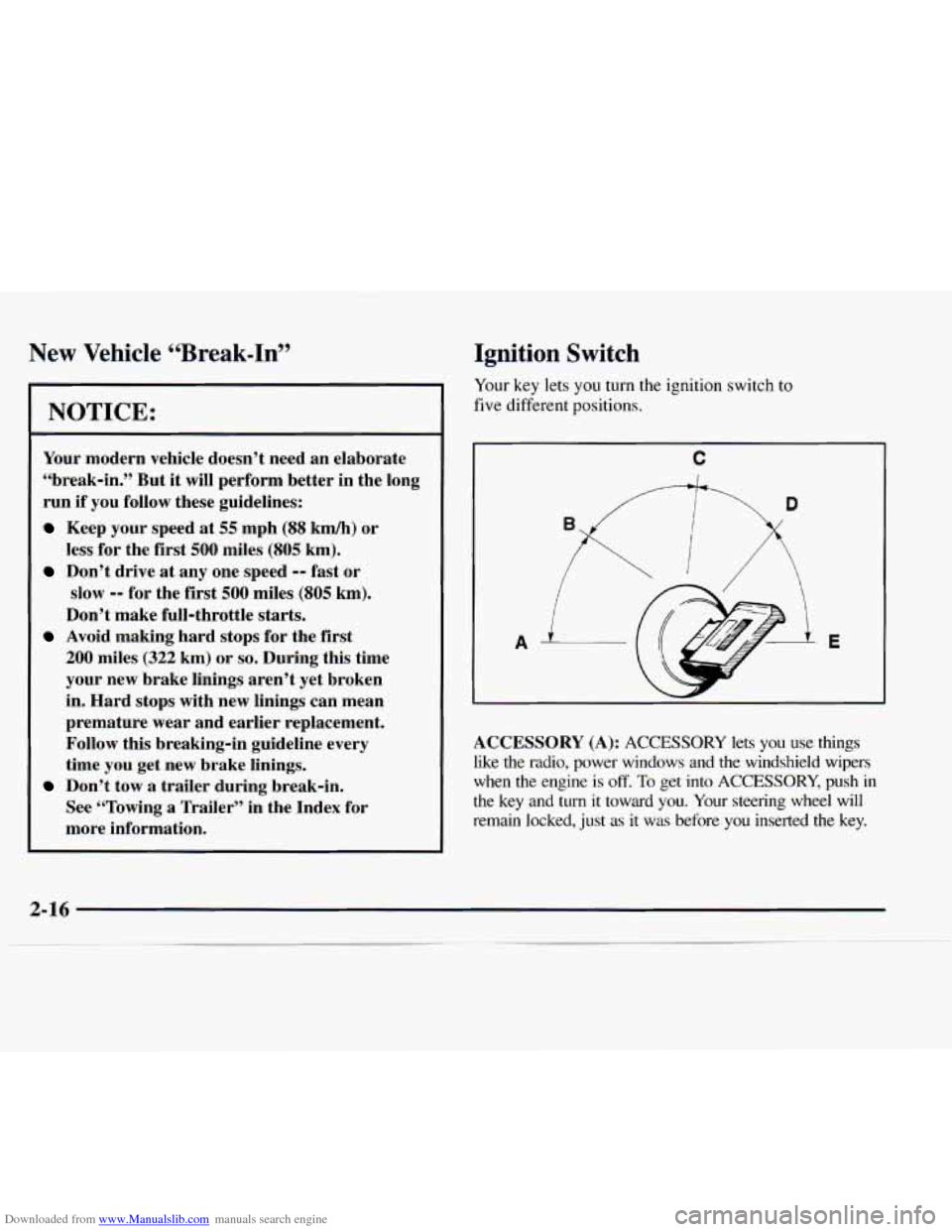
Downloaded from www.Manualslib.com manuals search engine New Vehicle “Break-In”
NOTICE:
Your modern vehicle doesn’t need an elaborate
“break-in.” But it will perform better in the long
run if you follow these guidelines:
Keep your speed at 55 mph (88 kmh) or
less for the first
500 miles (805 km).
Don’t drive at any one speed -- fast or
slow
-- for the first 500 miles (805 km).
Don’t make full-throttle starts.
200 miles (322 km) or so. During this time
your new brake linings aren’t yet broken
in. Hard stops with new linings can mean
premature wear and earlier replacement.
Follow this breaking-in guideline every
time you get new brake linings.
See “Towing
a Trailer” in the Index for
more information.
Avoid making hard stops for the first
Don’t tow a trailer during break-in.
Ignition Switch
Your key lets you turn the ignition switch to
five different positions.
C
ACCESSORY (A): ACCESSORY lets you use things
like the radio, power windows and the windshield wipers
when the engine is
off. To get into ACCESSORY, push in
the key and turn
it toward you. Your steering wheel will
remain locked, just
as it was before you inserted the key.
Page 89 of 386
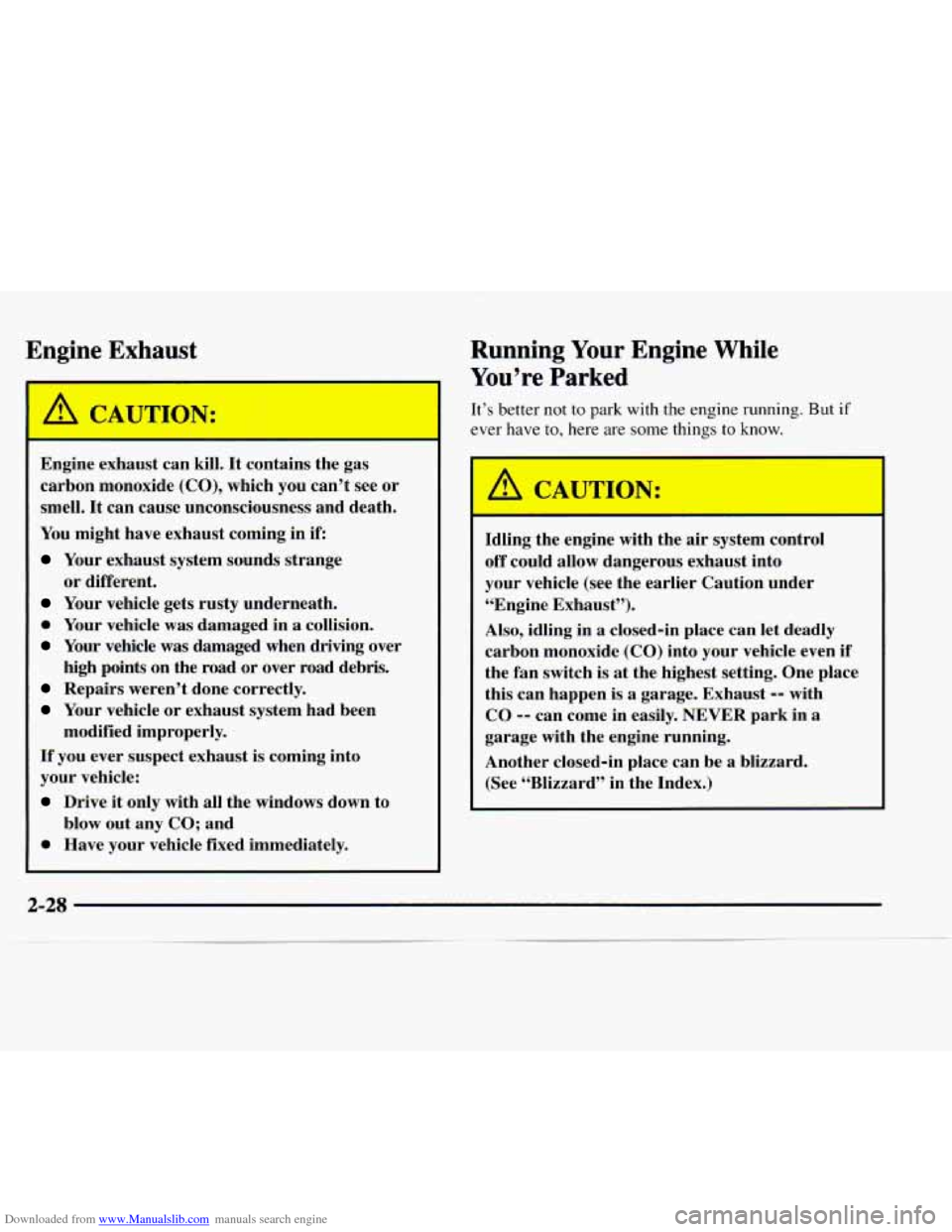
Downloaded from www.Manualslib.com manuals search engine Engine Exhaust
I
Engine exhaust can kill. It contains the gas
carbon monoxide
(CO), which you can’t see or
sm.el1. It can cause unconsciousness and death.
You might have exhaust coming in if:
Your exhaust system sounds strange
Your vehicle gets rusty underneath.
0 Your vehicle was damaged in a collision.
Your vehicle was damaged when driving over
high points on the road
or over road debris.
Repairs weren’t done correctly.
Your vehicle or exhaust system had been
If you ever suspect exhaust is coming into
your vehicle:
Drive it only with all the windows down to
0 Have your vehicle fixed immediately.
or different.
modified improperly.
blow out any
CO; and
Running Your Engine While
You’re Parked
It’s better not to park with the engine running. But if
ever have to, here are some things to know.
Idling the engine with the air system contrl
off could allow dangerous exhaust into
your vehicle (see the earlier Caution under
“Engine Exhaust”).
Also, idling in a closed-in place can
let deadly
carbon monoxide
(CO) into your vehicle even if
the fan switch is at the highest setting. One place
this can happen is a garage. Exhaust
-- with
CO -- can come in easily. NEVER park in a
garage with the engine running.
Another closed-in place can be
a blizzard.
(See “Blizzard” in the Index.)
2-28